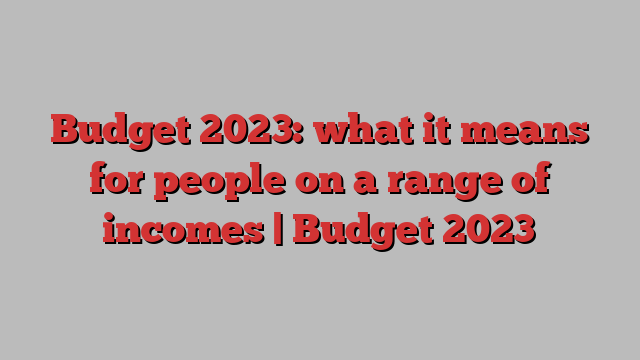
Single
Low income

2022/23 James, 24, works 35 hours a week for a cafe and is paid the minimum wage of £9.50 an hour, or £332.50 a week. From his annual wage of £15,960 he is left with £14,761, after tax (£678) and national insurance (£521) are both deducted.
2023/24 From April the minimum wage for over-23s in rises to £10.42 an hour. This means he now receives £364.70 a week or £17,506 a year. After tax and NI are deducted he is left with £15,926 – £1,165 more than the previous year.
Single
Average earner

2022/23 Helen earns the national average wage of £38,000 and pays £5,086 a year in income tax and a national insurance bill of £3,326. Her monthly take-home pay is £2,466 after tax, or £29,589 a year.
2023/24 Having had a good year, her employer has awarded her £4,000 – a 10.5% – pay rise. As a result her tax bill rises to £5,886 while she pays £3,532 NI. After a £4,000 pay rise, she is actually £2,995 a year net better off.
Cohabiting couple
Both unemployed but looking for work, two children

2022/23 Jane and Peter both were recently laid off by the pub they worked at when it suddenly closed, and are currently relying on benefits. They receive £194 a week in universal credit, £77/week in new-style jobseeker’s allowance each and £36.25 child benefit. Once council tax support is added, they receive a total of £390 a week, or £1,690 a month, of which almost half goes on rent. They also receive cost of living payments worth £650.
2023/24 The chancellor said last autumn that benefits would rise by 10.1%, meaning their benefits package is now worth an extra £39 a week or £169 a month. Their landlord has said he is raising their rent from £800 to £900 a month swallowing up most of the increase. Their cost of living payments rises to £900 to help with higher energy, food and other costs.
Married couple, two children
One income of £49,000
2022/23 The working parent, Sandra, pays £7,286 income tax and £4,726 in national insurance. This translates into a net annual salary of £36,988 or £3,082 a month. The family currently receive child benefit which is worth £1,885 a year – giving a total income of £38,873.
2023/24 After a £6,000 a year pay increase, Sandra becomes a higher rate taxpayer for the first time. Her net income rises to £40,949 or £3,412 a month. Their child benefit would be worth £2,075 a year, but because she earns more than £50,000 a year, she also now faces the high income child benefit tax charge, that in this case cuts the child benefit payments in half. Despite a £6,000 pay rise the family is just £3,113 year better off – she has been taxed at almost 50% of her increase.
Married couple, no kids
First income £150,000, second income £85,000

2022/23 Out of Fred’s £150,000 annual salary, he pays £52,460 income tax and £7,610 in national insurance, leaving him with a net £89,930 a year. After deductions, Paddy’s £85,000 is worth £57,732. This gives them a combined net income of £147,662 a year or £12,305 a month.
2023/24 Both have managed to secure a 10% pay rise from their private sector employers. Their NI bills both fall due to the NI cuts announced last autumn – in Fred’s case by £791 a year. Out of their combined new salary of £258,500 they are left with a net income of £161,008 a year – a jump of £13,345 a year or £1,112 more a month.
Single pensioner
New state pension

2022/23 Wendy’s state pension is £185.15 a week or £9,628 a year. She also qualified for £950 of cost of living payments, give a total of £10,528 a year.
2023/24 This pensioner will benefit from the 10.1% benefits uplift. Her basic pensions will rise by £18.70 a week. She will receive cost of living payments worth £1,200 over the coming year. Overall, she is £1,272 a year better off.
Married pensioners
State pension plus plus £8,000 private pension

2022/23 Once the first state pension is combined with the income from the private one, the holder receives a net income of £15,392 a year. From this they lose £564 to income tax. The second pension is worth £4,420 a year giving a net, combined income of £19,248.
2023/24 After the benefits rise of 10.1% is applied their tax bill increases to £710 a year. Their income from the private pension is unchanged, meaning they have been hit hard by inflation over the last year. Overall they are £1,050 better off this year than last.